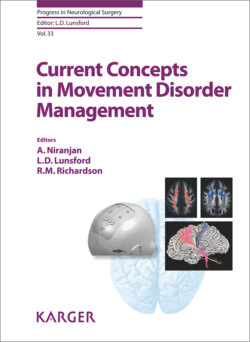Читать книгу Current Concepts in Movement Disorder Management - Группа авторов - Страница 32
Pattern Changes in Parkinsonism
ОглавлениеWhile appealing because of its simplicity, the aforementioned rate model of PD provides at best a partial explanation for the observed movement abnormalities in PD. It is, therefore, widely believed that changes in discharge patterns are at least as important as rate changes in the basal ganglia (see review and additional references in ref. [4]). One of the most discussed changes in the patterning of basal ganglia activity in parkinsonian subjects is the development of oscillatory fluctuations of neuronal spiking activities, which can be identified in electrophysiological recordings of the activity of single neurons in GPi, SNr, and STN in animals and patients, as well as downstream from the basal ganglia, in the thalamus, and in pyramidal tract neurons of the motor cortex. These oscillations are easily identified with spectral analysis techniques, and affect mostly frequencies below 30 Hz.
Another parkinsonism-related abnormality in spontaneous cellular discharge is the emergence of abnormal synchrony between neurons. Under physiologic conditions, individual basal ganglia neurons respond in a specific manner to active or passive movements, and neighboring neurons are rarely found to fire in synchrony. In parkinsonism, the segregation is lost and the discharge of neighboring neurons is often correlated and abnormally synchronized. Finally, the proportion of cells in STN, GPi, and SNr that discharge in bursts (oscillatory or non-oscillatory) is greatly increased in parkinsonism. Synchronized oscillatory burst discharge patterns are also seen, often (but not exclusively) in conjunction with tremor, which may reflect tremor-related proprioceptive input or an active participation of basal ganglia in the generation of tremor.
Oscillations can also be identified in recordings of local field potentials (LFPs), recorded with acutely or chronically placed macroelectrodes. LFP oscillations reflect synchronized oscillatory activities of membrane potentials of neuronal assemblies, strongly driven by synchronized inputs. Recordings in the human and animal STN and other basal ganglia areas have demonstrated the presence of LFP oscillations in the 10–25 Hz (beta) range in STN, GPi, and cortex in the unmedicated parkinsonian state. The prominence of beta-band activity is apparent throughout the basal ganglia-thalamocortical circuitry. Studies in humans have also shown that beta range oscillations give way to prominent oscillations in the 60–80 Hz (gamma) range when patients are treated with levodopa or when the STN is stimulated at high frequencies. The desynchronization of EEG oscillations that normally precedes movement was shown to be abnormally small in unmedicated parkinsonian patients, perhaps interfering with the initiation of movement. Most recently, abnormal coupling of the amplitude of gamma-band oscillations and the phase of beta-band oscillations have been described in electrocorticogram and electroencephalographic signals.
While bursts of oscillatory activity in the basal ganglia-thalamocortical circuits are associated with parkinsonism, direct links between the oscillations and other electrophysiological abnormalities, and specific parkinsonian deficits have not (yet) been established. In fact, recent studies in monkeys in which repeated administration of low doses of MPTP progressively induced parkinsonism have cast doubt on the notion that synchronous oscillatory firing and LFP changes contribute strongly to (early) parkinsonism. The lack of a clearly established causal relationship between firing changes and parkinsonism suggest that the described abnormalities could be non-causal epiphenomena, or show that the abnormalities responsible for early parkinsonism are too subtle or regionally restricted to be detected with current recording methodology. However, the identified abnormalities appear to correlate with the severity of parkinsonian symptoms in later stages of the disease. Interestingly, these electrical signals have been shown to be useful as control signals for feedback-regulated deep brain stimulation in PD patients [5].
It should be noted that the pathophysiology of tremor is likely significantly different from that of other parkinsonian signs mentioned above. While bradykinesia and akinesia may be associated with (or even caused by) synchronized beta-band oscillations in the basal ganglia thalamocortical circuits, parkinsonian tremor appears to be strongly related to abnormal oscillatory activity in M1 and the thalamus, prominently involving the cerebellar receiving territory of the thalamus. Parkinsonian tremor responds to dopaminergic therapy (although often only to high doses), but it is not clear how dopamine loss is linked to tremor. The degree of dopamine loss in the striatum does not correlate with the severity of tremor, while the degree of dopamine loss in GPi and the retrorubral area does [6].
